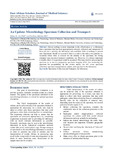Please use this identifier to cite or link to this item:
http://ir-library.mmust.ac.ke:8080/xmlui/handle/123456789/2029Full metadata record
| DC Field | Value | Language |
|---|---|---|
| dc.contributor.author | Iddah, M. Ali | - |
| dc.contributor.author | Maloba, Geoffrey | - |
| dc.date.accessioned | 2022-01-13T05:03:58Z | - |
| dc.date.available | 2022-01-13T05:03:58Z | - |
| dc.date.issued | 2021-06-12 | - |
| dc.identifier.uri | https://doi.org/10.36349/easms.2021.v04i05.002 | - |
| dc.identifier.uri | http://ir-library.mmust.ac.ke:8080/xmlui/handle/123456789/2029 | - |
| dc.description.abstract | Almost nothing is more important to the effectiveness of a laboratory than a specimen that has been appropriately selected, collected, and transported. If these are not a priority, the laboratory can contribute little or nothing to patient care. Specimens should be rejected if there is a risk to the safety of a patient; i.e. occasions where there is concern for the identity of the specimen, the wrong container type, incorrect transport conditions, etc. However, it is always important to double check if a specimen could be accepted. This may involve processing the specimen so as not to compromise specimen integrity while also evaluating the specimen for acceptability. In this review article, we will cover specimen collection, specimen transportation, culture, and rejection by the laboratory. | en_US |
| dc.language.iso | en | en_US |
| dc.publisher | East African Scholars Journal of Medical Sciences | en_US |
| dc.subject | Update,Microbiology, Specimen, Collection ,Transport | en_US |
| dc.title | An Update: Microbiology Specimen Collection and Transport | en_US |
| dc.type | Article | en_US |
| Appears in Collections: | Journal Articles | |
Files in This Item:
| File | Description | Size | Format | |
|---|---|---|---|---|
| An Update Microbiology Specimen Collection and Transport.pdf | 205.51 kB | Adobe PDF |  View/Open |
Items in DSpace are protected by copyright, with all rights reserved, unless otherwise indicated.
